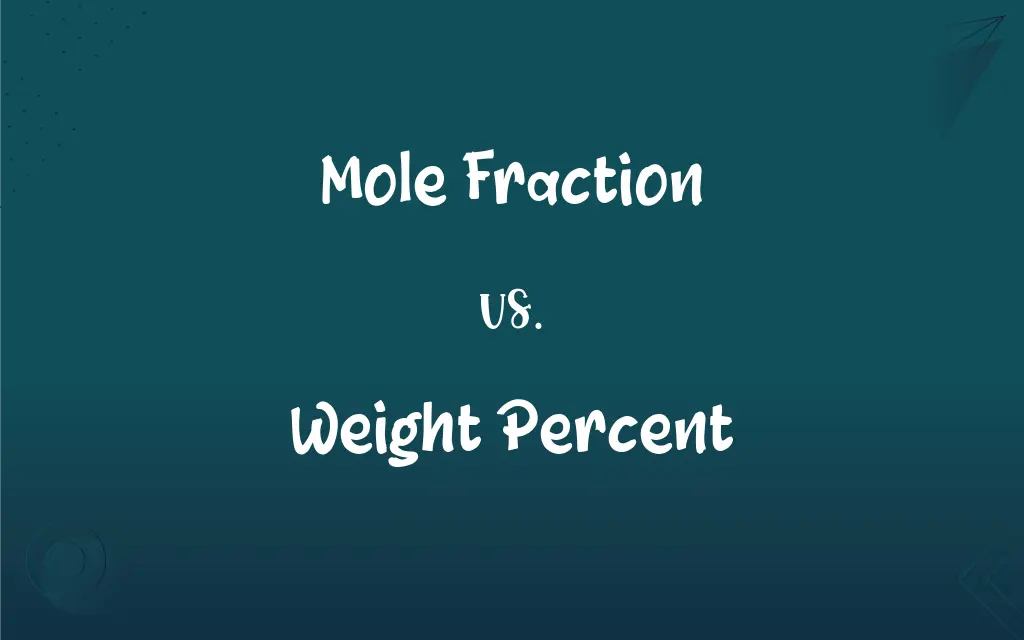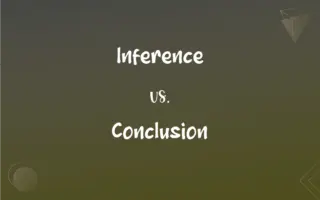Mole Fraction vs. Weight Percent: What's the Difference?
Edited by Aimie Carlson || By Janet White || Published on December 1, 2023
Mole fraction is the ratio of moles of a component to the total moles in a mixture, while weight percent is the ratio of a component's weight to the total mixture's weight, multiplied by 100.

Key Differences
Mole fraction, denoted by a dimensionless number, measures the proportion of a constituent relative to the total number of moles in a mixture. Weight percent, however, expressed as a percentage, indicates the mass of a component as a proportion of the total mass of the mixture.
The mole fraction is independent of temperature and pressure because it is a ratio of counts of molecules. Weight percent can vary with changes in temperature or pressure, as these can affect the density and therefore the weight of the components.
Calculating mole fraction involves counting moles, which are a measure of the number of particles in a substance. To calculate weight percent, one must weigh the components, considering the mass of each substance in the mixture.
Mole fraction is particularly useful in gas mixtures and when dealing with reactions and stoichiometry. Weight percent is commonly used in solutions and is practical in industries where weight measurements are more feasible.
Mole fraction gives a direct representation of the composition in terms of molecule counts, while weight percent provides a more intuitive understanding of composition in terms of mass.
ADVERTISEMENT
Comparison Chart
Definition
Ratio of moles of a component to total moles
Ratio of component's weight to total weight
Expression
Dimensionless number
Percentage (%)
Dependency
Independent of temperature and pressure
Can vary with temperature and pressure
Calculation Basis
Based on number of particles (moles)
Based on mass of substances
Common Usage
Used in gas mixtures and stoichiometry
Used in solutions and practical applications
ADVERTISEMENT
Mole Fraction and Weight Percent Definitions
Mole Fraction
Mole fraction is used to express the concentration of a component in a mixture.
The mole fraction of the solute determined its role in the chemical reaction.
Weight Percent
Weight percent measures the mass of a component as a part of the total mass of a mixture.
The weight percent of salt in the solution was 10%.
Mole Fraction
It is a way of expressing composition in a multi-component system.
In the alloy, the mole fraction of each metal was crucial for its properties.
Weight Percent
Weight percent is used in formulations to specify the amount of each ingredient.
In the paint, the pigment had a weight percent of 2%.
Mole Fraction
Mole fraction, a unitless quantity, helps in calculating partial pressures in gases.
We used the mole fraction to find the partial pressure of each gas in the mixture.
Weight Percent
It expresses the concentration of a substance in terms of its weight.
The weight percent of the active ingredient in the cream was 5%.
Mole Fraction
It represents the fraction of a component in terms of its molecular count.
The mole fraction of oxygen in air is approximately 0.21.
Weight Percent
Weight percent gives an intuitive understanding of a mixture's composition by mass.
The weight percent of each metal in the alloy determined its hardness.
Mole Fraction
Mole fraction is the proportion of a substance's moles to the total moles in a mixture.
In the mixture, the mole fraction of nitrogen was calculated to be 0.7.
Weight Percent
It's a common method to describe the composition of mixtures in industries.
Manufacturers listed the components by weight percent on the product label.
FAQs
What is mole fraction?
It's the ratio of the number of moles of a component to the total number of moles in a mixture.
How is mole fraction calculated?
By dividing the moles of a component by the total moles in the mixture.
What is weight percent?
The percentage ratio of a component’s weight to the total weight of a mixture.
How is weight percent determined?
By dividing the weight of a component by the total weight of the mixture and multiplying by 100.
Is mole fraction affected by temperature?
No, it remains constant regardless of temperature changes.
How does mole fraction relate to chemical reactions?
It helps in stoichiometric calculations and understanding reactant proportions.
In which applications is weight percent commonly used?
In solutions, manufacturing, and any situation where weight-based concentration is relevant.
Can mole fraction exceed 1?
No, it's always a value between 0 and 1.
Why is mole fraction used in gas mixtures?
It simplifies calculations like partial pressures and is independent of conditions.
Is mole fraction a unitless measure?
Yes, it’s expressed as a dimensionless ratio.
Does mole fraction have any limitations?
It may be less intuitive than mass-based measures for some practical applications.
How important is mole fraction in gas laws?
It’s crucial for calculations involving gas mixtures and partial pressures.
Does weight percent change with temperature?
Yes, it can change due to density variations caused by temperature fluctuations.
Can weight percent be more than 100%?
No, it’s always within 0 to 100%.
Why is weight percent useful in industry?
It provides a straightforward way to convey composition by mass, which is practical for formulation and production.
Can mole fraction be used in solids?
Yes, it's applicable to any phase of matter.
Is weight percent suitable for volatile components?
Care must be taken as volatiles can affect the accuracy of weight measurements.
Is weight percent used in pharmaceutical formulations?
Yes, to specify the concentration of each component in drugs.
Is weight percent easy to measure?
Yes, as it involves straightforward weighing, it’s easy to measure.
What’s a common use of weight percent in consumer products?
Listing ingredient concentrations in products like cosmetics and food.
About Author
Written by
Janet WhiteJanet White has been an esteemed writer and blogger for Difference Wiki. Holding a Master's degree in Science and Medical Journalism from the prestigious Boston University, she has consistently demonstrated her expertise and passion for her field. When she's not immersed in her work, Janet relishes her time exercising, delving into a good book, and cherishing moments with friends and family.
Edited by
Aimie CarlsonAimie Carlson, holding a master's degree in English literature, is a fervent English language enthusiast. She lends her writing talents to Difference Wiki, a prominent website that specializes in comparisons, offering readers insightful analyses that both captivate and inform.






































































